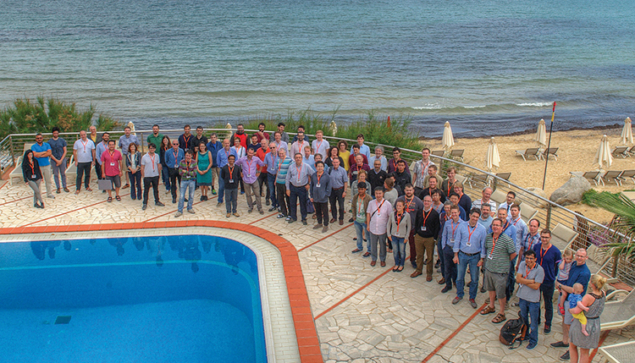
The international conference devoted to B physics at frontier machines, Beauty 2018, was held in La Biodola, Isola d’Elba, Italy, from 6–11 May, organised by INFN Pisa. The aims of the conference series are to review the latest results in heavy-flavour physics and discuss future directions. This year’s edition, the 17th in the series, attracted around 80 scientists from all over the world. The programme comprised 58 invited talks, of which 13 were theory-based.
In recent years, several puzzling anomalies have emerged from LHCb and b-factory data (CERN Courier April 2018 p23), and discussion of these set the scene for a very inspiring atmosphere at the conference.
Heavy-flavour decays, in particular those of hadrons that contain b quarks, offer powerful probes of physics beyond the Standard Model (SM). In recent years, several puzzling anomalies have emerged from LHCb and b-factory data (CERN Courier April 2018 p23), and discussion of these set the scene for a very inspiring atmosphere at the conference. In particular, the ratio of branching fractions RD(*) = BR(B → D(*)τν)/BR(B → D(*)lν), where l = μ, e, provide a test of lepton universality and, intriguingly, now give combined experimental values which are about 4σ away from the SM expectations. Furthermore, the ratios RK = BR(B+ → K+μ+μ–)/BR(B+ → K+e+e–) and the corresponding measurement, RK*, yield results that are each around 2.5σ away from unity. Other potential deviations from the SM are seen in the observable, P5´, of the angular distribution of decay products in the rare decay B0 → K*μ+μ–, and also measurements in related decay channels. Hence, the release of new LHCb results from LHC Run 2 is eagerly awaited later this year.
The rare decay Bs → μ+μ–, already observed at the 6σ level two years ago by a combined analysis of CMS and LHCb data, has now been observed by LHCb alone at a level greater than 5σ, and is consistent with the SM. The effective lifetime of the decay offers additional tests of new physics, and a first measurement has now been made: 2.04 ± 0.44 (stat) ± 0.05 (syst) ps – also consistent with the SM but with large uncertainties.
Theoretical overview talks put recent results such as those above in context. Regarding the flavour anomalies, models involving leptoquarks and new Z´ bosons are currently receiving much attention. Impressive progress has also been made in lattice-QCD calculations and in our understanding of hadronic form factors, which are crucial as inputs for theoretical predictions. Continued interplay between theory and experiment will be essential to understand the emerging data from the LHC and also from the Belle-II experiment in Japan, which has recently started taking data (CERN Courier June 2018 p7).
Concerning CP violation in the b sector, LHCb reported a new world-best determination of the angle γ of the unitarity triangle from a combination of measurements: degrees, which differs from the prediction from other unitarity-triangle constraints by around 2σ. Regarding CP violation in Bs0 → J/ψ φ decays, which is predicted to be very small in the SM, the experimental knowledge from a combination of LHC experiments has now reached φs = 21 ± 31 mrad, which is compatible with the SM.
Presentations were also devoted to hadron spectroscopy and exotic states, where there has been huge interest since the recent discovery of pentaquark-like states by LHCb (CERN Courier April 207 p31). The udsb tetraquark candidate reported by the D0 experiment at Fermilab just over two years ago has not been confirmed in LHC data and, significantly, neither by its sister experiment CDF. A plethora of other new results were reported at Beauty 2018, including from LHCb: a doubly-charmed baryon, Ξcc++, and a Ξb**− state, as well as a spectroscopy “gold mine” of X, Y and Z states from BES-III in China. Kaon physics was also discussed. With the completion of 2016 data analysis, the NA62 experiment at CERN has reached SM-sensitivity for the ultra-rare K+ → π+νν– decay channel. A single candidate event was found with 0.15 background events expected, and a lower limit on the branching ratio of 14 × 10−10 at 95% confidence has been set.
The future experimental programme of flavour physics is full of promise. One of the highlights of the conference was a report on first data from Belle-II; further exciting options will emerge beyond 2021 when LHC Run 3 commences, with LHCb running at an increased luminosity of 2 × 1033 cm−2s−1 with an improved trigger, and high-luminosity upgrades to ATLAS and CMS to follow. The scientific programme of Beauty 2018 was complemented by a variety of social events, which, coupled with the stimulating presentations, made the conference a huge success at this exciting time for B physics.







